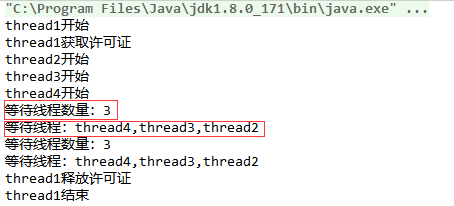JUC的Semaphore俗称信号量,可用来控制同时访问特定资源的线程数量。通过它的构造函数我们可以指定信号量(称为许可证permits可能更为明确)的数量,线程可以调用Semaphore对象的acquire方法获取一个许可证,调用release来归还一个许可证。
Semaphore示例
1 | public class SemaphoreTest { |
上面的例子中,我们定义许可证的数量为2个,然后4个线程通过acquire方法去获取许可证,结束行通过release方法释放许可证。acquire方法默认一次只拿一个许可证,所以上面的例子中,同一时刻最多只有两个线程同时执行。
程序输出如下所示: 
acquire的重载方法acquire(int permits)允许线程一次性获取N个许可证;同样的release的重载方法release(int permits)允许线程一次性释放N个许可证。
Semaphore还有一个tryAcquire,它允许线程尝试去获取1个许可证,如果许可证不足没有获取到的话,线程也会继续执行,而非阻塞等待。tryAcquire方法的重载方法tryAcquire(long timeout, TimeUnit unit)可以指定尝试获取许可证的超时时间。
acquireUninterruptibly
从上面的例子我们会发现acquire方法会抛出InterruptedException异常,说明这个方法是可以被打断的:
1 | public class SemaphoreTest { |
上面例子thread1线程获取2个许可证,但许可证总数只有1个,所以会阻塞等待。main线程通过调用thread1的interrupt方法去打断thread1线程,结果如下:

而通过acquireUninterruptibly方法去获取许可证是不可被打断的:
1 | public class SemaphoreTest { |
上面程序并不会抛出InterruptedException,thread1会一直处于阻塞状态。
drainPermits
drainPermits方法一次性获取所有许可证(drain抽干榨干😮):
1 | public class SemaphoreTest { |
availablePermits方法用于获取当前可用许可证数量的预估值。程序输出如下:

别的API
hasQueuedThreads方法用于判断是否有处于等待获取许可证状态的线程;getQueueLength用于获取处于等待获取许可证状态的线程的数量;getQueuedThreads用于获取处于等待获取许可证状态的线程集合。
getQueuedThreads是protected的,所以要使用它,我们得自定义一个Semaphore的子类:
1 | public class SemaphoreTest { |
程序输出如下所示(截取一部分): 
Api总结
总结下Semaphore常用的方法:
| 方法 | 描述 |
|---|---|
acquire() | 获取一个许可证,可以被打断,没有足够的许可证时阻塞等待 |
acquire(int permits) | 获取指定数量的许可证,可以被打断,没有足够的许可证时阻塞等待 |
acquireUninterruptibly() | 获取一个许可证,不可被打断,没有足够的许可证时阻塞等待 |
acquireUninterruptibly(int permits) | 获取指定数量的许可证,不可被打断,没有足够的许可证时阻塞等待 |
tryAcquire() | 尝试获取一个许可证,没有足够的许可证时程序继续执行,不会被阻塞 |
tryAcquire(int permits) | 尝试获取指定数量的许可证,没有足够的许可证时程序继续执行,不会被阻塞 |
tryAcquire(long timeout, TimeUnit unit) | 在指定的时间范围内尝试获取1个许可证,没有足够的许可证时程序继续执行, 不会被阻塞,在该时间方位内可以被打断 |
tryAcquire(int permits, long timeout, TimeUnit unit) | 在指定的时间范围内尝试获取指定数量的许可证,没有足够的许可证时程序 继续执行,不会被阻塞,在该时间方位内可以被打断 |
release() | 释放一个许可证 |
drainPermits() | 一次性获取所有可用的许可证 |
availablePermits() | 获取当前可用许可证数量的预估值 |
hasQueuedThreads() | 判断是否有处于等待获取许可证状态的线程 |
getQueueLength() | 获取处于等待获取许可证状态的线程的数量的预估值 |
getQueuedThreads() | 获取处于等待获取许可证状态的线程集合 |

